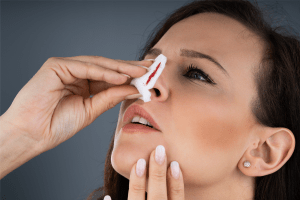Nasal turbinates, also known as nasal conchae, are structures within the nasal cavity that play a crucial role in your respiratory system. They moisten and filter the air you breathe to prevent nasal dryness, infection, and irritation. If you’re experiencing frequent nasal stuffiness, sinus infections, nosebleeds, or general discomfort due to swollen, inflamed, or enlarged turbinates (in some cases turbinate hypertrophy), there’s a possibility that you may benefit from nasal turbinate reduction. Continue reading to learn the types of nasal turbinate reduction in Los Angeles available so you can make the best-informed decision regarding treatment.
The Role of Turbinates in the Respiratory System
As we breathe, air enters the nasal cavity. The turbinates, covered by mucous membranes, help filter out dust, pollen, and other airborne particles. These tiny hair-like structures called cilia on the turbinates’ surface help trap these particles and prevent them from entering the lungs.
The blood vessels in the mucous membrane of the turbinates warm the air as it passes over them. This ensures that the air reaching the lungs is close to body temperature. The mucous membrane also adds moisture to the air, humidifying it. This humidification is essential to prevent the drying out of the lungs and bronchial tubes.
The superior turbinate and the region directly above it houses the olfactory bulb and nerve endings responsible for your sense of smell. As air swirls around the turbinates, odorous molecules are directed towards these nerve endings, allowing us to detect different scents. The size and shape of the turbinates help regulate and direct airflow.
They ensure that air flows smoothly without turbulence from the nasal cavity to the throat and into the lungs. The turbinates can change their size to control airflow. For instance, when we’re at rest, they might swell slightly to reduce airflow. Conversely, during physical activity, they might constrict to allow a larger volume of air to pass through.
The mucous membranes of the turbinates produce mucus that can trap pathogens like bacteria and viruses. This mucus, along with the trapped pathogens, is gradually moved to the back of the throat by the cilia and is either swallowed or coughed out, preventing infections.
Symptoms of Enlarged Nasal Turbinates

- Nasal Congestion or Obstruction: This is one of the most common symptoms. An individual may feel like their nose is perpetually blocked, making it hard to breathe through one or both nostrils.
- Frequent Nosebleeds: Enlarged turbinates can make the nasal lining more prone to dryness and bleeding.
- Snoring: Due to the obstruction caused by the enlarged turbinates, snoring can become more frequent and intense.
- Postnasal Drip: This refers to the feeling of mucus continuously dripping down the back of the throat.
- Facial Pain or Pressure: Especially in the area around the nose and sinuses.
- Decreased Sense of Smell: Nasal obstruction can lead to a reduced ability to smell.
- Mouth Breathing: Due to the inability to comfortably breathe through the nose, one might resort to breathing through the mouth, especially during sleep.
- Sleep Disturbances: Such as difficulty falling asleep or frequent awakenings because of breathing difficulties. In severe cases, it may contribute to conditions like sleep apnea.
- Headaches: Especially upon waking, due to the reduced airflow and potential buildup of carbon dioxide.
- Recurrent Sinus Infections: Blocked nasal passages can lead to frequent sinusitis or sinus infections.
- Dry Mouth: This can result from mouth breathing and can lead to dental issues and bad breath.
- Decreased Taste Sensation: Due to the close relationship between taste and smell, nasal blockage can affect the sense of taste.
If someone suspects they have enlarged turbinates, it’s important to seek an evaluation from an otolaryngologist or ENT specialist. They can provide a proper diagnosis and recommend suitable treatment options.
Treatments to Consider Before Nasal Turbinate Reduction in Los Angeles
Before considering turbinate surgery, there are several non-surgical treatments and interventions that can be tried to alleviate symptoms of nasal obstruction caused by enlarged turbinates. Here are some treatments to consider:
Nasal Steroid Sprays
These are the most commonly prescribed treatments for turbinate enlargement. They can reduce inflammation and swelling in the nasal passages. Examples include fluticasone (Flonase), triamcinolone (Nasacort), and mometasone (Nasonex).
Antihistamines
If allergies are a contributing factor to turbinate enlargement, antihistamines can help by reducing the allergic response. Antihistamines are available as over the counter products and by prescription.
Decongestant Sprays and Pills
These can offer temporary relief from nasal congestion by narrowing the blood vessels in the nasal passages. However, they should not be used for more than 3-5 consecutive days, as they can cause a rebound effect (increased swelling after stopping).
Saline Nasal Sprays and Nasal Irrigation
Saline solutions can help moisturize the nasal passages, reduce inflammation, and clear out allergens and mucus. Using a neti pot or squeeze bottle, saline solution is passed through the nasal passages to clear mucus and allergens.
Allergy Immunotherapy
Allergy shots or sublingual immunotherapy tablets can be effective for those whose turbinate issues are driven primarily by allergies. This treatment exposes the patient to increasing amounts of allergens over time, aiming to decrease sensitivity and reactions.
Environmental Changes
Reducing allergens at home can help. This can include using allergen proof bed encasements, high efficiency particulate air (HEPA) filters, keeping windows closed during high pollen days, and avoiding known allergens.
Corticosteroid Injections
Steroid injections directly into the turbinates can reduce their size. This is usually a temporary solution and not often performed due to significant complications associated with it.
Turbinate reduction surgery is an option if these treatments do not provide noticeable relief or for cases with severe symptoms. Always discuss potential risks and benefits of any treatment with an otolaryngologist or ENT specialist.
Three Types of Turbinate Reduction in Los Angeles
Radiofrequency Reduction is a minimally invasive procedure that uses a needle electrode to deliver radiofrequency energy to the turbinate. This energy creates lesions within the turbinate tissue. Over time, the lesions heal and result in a reduction of the turbinate size. RFTR usually has a shorter recovery time compared to more invasive surgical methods. Patients might experience some congestion, minor bleeding, or crusting. It’s often performed under local anesthesia in the office and is less invasive than other procedures but does not have good long term results.
Coblation Turbinate Reduction (CTR) uses low temperature radiofrequency to dissolve a portion of the turbinate, thereby reducing its size. A specialized device is introduced into the turbinate, which then removes tissue without generating significant heat, thus minimizing damage to surrounding tissues. Recovery is similar to RFTR, as there may be mild discomfort, congestion, or minor bleeding post procedure. Overall, CTR is a relatively quick procedure that takes less than 15 minutes to perform in an office setting with local anesthesia.
Microdebrider Turbinoplasty is a surgical technique used to reduce the size of the nasal turbinates, to improve airflow and alleviate symptoms of nasal obstruction. The procedure makes use of a microdebrider, a specialized surgical instrument. Microdebrider turbinoplasty offers a precise and effective method for reducing enlarged turbinates and improving nasal obstruction. As with any surgical procedure, potential risks and benefits should be discussed in detail with an otolaryngologist or ENT specialist. However this procedure often performed in the office under local anesthesia has the best long term results and least amount of side effects when performed properly.
Key Takeaways on Choosing the Right Nasal Turbinate Reduction Procedure
Nasal turbinates are more than just structures in the nose; they play a multifaceted role in ensuring that the air we breathe is clean, warm, and moist, optimizing lung function and overall respiratory health. When there are issues with the turbinates, such as inflammation or enlargement (hypertrophy), it can lead to breathing difficulties and necessitate medical intervention.
The most common procedures include radio turbinate reduction (RFTR), turbinate coblation, and microdebrider turbinoplasty. These three treatments reduce the size of enlarged or hypertrophied nasal turbinates to alleviate nasal obstruction and improve airflow through the upper airways.
While there are a variety of nasal turbinate reduction procedures available, choosing the right solution requires patients to discuss their symptoms and medical history with a board-certified ENT specialist to learn the risks, benefits and expected outcomes of each for their situation and receive a tailored treatment plan.

